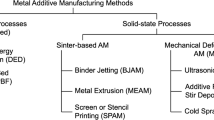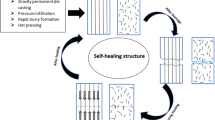Abstract
An experimental study has been conducted with the purpose of examining the fatigue crack growth characteristics of cast aluminum alloy matrix composites reinforced with different vol- ume fractions of silicon carbide particles. Particular attention has been paid to developing com- posite microstructures with similar matrix aging condition, precipitation, matrix strength, reinforcement particle size distribution, and interfacial characteristics but with different con- trolled amounts of reinforcement particles. Fatigue crack growth experiments have been con- ducted using constant stress amplitude methods with a fixed load ratio as well as constant Kmax control involving a varying load ratio. The development of crack closure and the microscopic path of the crack through the composite microstructure are monitored optically and using the electron microscope in an attempt to examine the mechanisms of fatigue fracture. The results indicate that an increase in SiC content results in the suppression of striation formation in the ductile matrix. Although ductile matrix failure involving the formation of striations in the low SiC content composite or of void growth in the high SiC content composite is evident, the results also show that fracture of the reinforcement particles plays a significant role in dictating the rates of fatigue crack growth. Detailed quantitative analyses of the extent of particle fracture as a function of the reinforcement content have been performed to elucidate the mechanistic origins of fatigue resistance. The propensity of particle fracture increases with particle size and with the imposed value of stress intensity factor range. While discontinuously reinforced metal- matrix composites with predominantly matrix cracking are known to exhibit superior fatigue crack growth resistance as compared to the unreinforced matrix alloy, the tendency for particle fracture in the present set of experiments appears to engender fatigue fracture characteristics in the composite which are inferior to those seen in the unreinforced matrix material. Particle fracture also results in noticeable differences in the microscopic fracture path and causes a reduction in crack closure in the composites as compared to that in the matrix alloy. The results of this work are discussed in light of other related studies available in the literature in an attempt to develop a mechanistic perspective on fatigue crack growth resistance in metal-matrix composites.
Similar content being viewed by others
References
A.P. Divecha, C.R. Crowe, and S.G. Fishman:Failure Modes in Composites IV, TMS-AIME, Warrendale, PA, 1977, p. 406.
A.P. Divecha, S.G. Fishman, and S.D. Karmarkar:J. Met., 1981, vol. 33, p. 12.
D.C. Drucker:J. Mater. Sci., 1966, vol. 1, p. 873.
D.A. Koss and S.M. Copley:Metall. Trans. A, 1971, vol. 2, pp. 1557–60.
C.H. Anderson and R. Warren:J. Compos. Mater., 1984, vol. 15, p. 16.
M. Taya and R.J. Arsenault:Metal Matrix Composites: Thermomechanical Behavior, Pergamon Press, Elmsford, NY, 1989.
L.M. Brown and W.M. Stobbs:Phil. Mag., 1971, vol. 23, p. 1185.
T. Christman, A. Needleman, and S. Suresh:Acta Metall., 1989, vol. 37, p. 3029.
J. Llorca, A. Needleman, and S. Suresh:Scripta Metall., 1990, vol. 24, p. 1203.
V.C. Nardone:Scripta Metall., 1987, vol. 21, p. 1313.
S.S. Yau and G. Mayer:Mater. Sci. Eng., 1986, vol. 82, p. 45.
W.A. Logsdon and P.K. Liaw:Eng. Fract. Mech., 1986, vol. 24, p. 737.
J.J. Bonnen, J.E. Allison, and J.W. Jones:Metall. Trans. A, 1991, vol. 22A, pp. 1007–19.
T. Christman and S. Suresh:Mater. Sci. Eng., 1988, vol. 102, p. 211.
J.K. Shang and R.O. Ritchie:Acta Metall., 1989, vol. 37, p. 2267.
S. Kumai, J.E. King, and J.F. Knott:Fat. Fract. Eng. Mater. Struct., 1990, vol. 13, p. 511.
A.J. Padkin, M.F. Bereton, and W.J. Plumbridge:Mater. Sci. Technol., 1987, vol. 3, p. 217.
K. Hirano: inProc. 4th Int. Conf. on Fatigue and Fatigue Thresholds, H. Kitagawa and T. Tanaka, eds., Materials and Component Engineering Publications Ltd., Birmingham, England, 1990, vol. 2, p. 863.
J. Llorca, S. Suresh, and A. Needleman:Metall. Trans. A, 1992, vol. 23A, pp. 919–34.
S. Suresh:Fatigue of Materials, Cambridge University Press, Cambridge, U.K., 1991.
D.L. Davidson:Eng. Fract. Mech., 1989, vol. 33, p. 965.
S. Kumai, J.E. King, and J.F. Knott:Fat. Fract. Eng. Mater. Struct., 1992, vol. 15, p. 1.
T. Christman and S. Suresh:Acta Metall., 1988, vol. 6, p. 1691.
S. Suresh, T. Christman, and Y. Sugimura:Scripta Metall., 1989, vol. 23, p. 1599.
I. Dutta and D.L. Bourell:Mater. Sci. Eng., 1989, vol. 112, p. 67.
K.K. Chawala, A.H. Esmaeili, A.K. Datye, and A.K. Vasudevan:Scripta Metall., 1991, vol. 25, p. 1315.
S. Suresh and K.K. Chawala: inFundamentals of Metal-Matrix Composites, S. Suresh, A. Mortensen, and A. Needleman, eds., Butterworth-Heinemann, Stoneham, MA, 1992, in press.
W.H. Hunt, J.R. Brochenbrough, and P.E. Magnusen:Scripta Metall., 1991, vol. 25, p. 15.
T. Mochida, M. Taya, and D.J. Lloyd:Mater. Trans. JIM, 1991, vol. 32, p. 931.
Author information
Authors and Affiliations
Rights and permissions
About this article
Cite this article
Sugimura, Y., Suresh, S. Effects of sic content on fatigue crack growth in Aluminum Alloys Reinforced with SiC Particles. Metall Trans A 23, 2231–2242 (1992). https://doi.org/10.1007/BF02646016
Received:
Published:
Issue Date:
DOI: https://doi.org/10.1007/BF02646016




